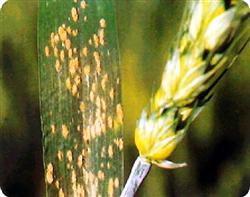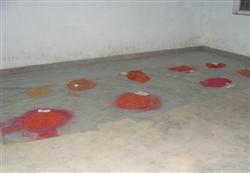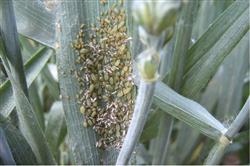How to control wheat diseases and insect pests

How to control wheat diseases and insect pests? Please give guidance and introduce the following control methods for the prevention and control of wheat diseases and insect pests: stripe rust: adopt the strategy of "finding one point and controlling one piece" in early spring, take medicine to detect and block the disease center, and combine spot control with general treatment in spring. according to the condition of seriously diseased fields and susceptible varieties, secondary spraying should be carried out. Select triadimefon, diniconazole, propiconazole and tebuconazole and other agents according to the required dose spray prevention and cure, and timely check and supplement spray. In spring, the panicle stage of the epidemic area should be combined with aphid control, "one spray and three control" should be adopted, specialized unified control should be carried out, and triadimefon, propiconazole or diniconazole should be sprayed according to the required dose. Scab: take the main strategy of spraying at heading and flowering stage. According to the forecast of weather trend, in the early stage of wheat heading and flowering in southwest wheat region and Huang-Huai wheat region, in case of more than three days of continuous rain, spray with the required dosage of carbendazim, tebuconazole, cyanostatin and prochloraz, etc. if it rains within 3 hours, it is necessary to clear and spray again. If there is continuous overcast and rainy weather in the wheat area of the Yangtze River basin, the growth period of wheat is irregular and the flowering period lasts for more than 7 days, and the medicine needs to be used again every 5-7 days after the first application to ensure the control effect. Aphids: it can be divided into two harmful stages: seedling aphid and ear aphid. The strategy of "picking and controlling seedling aphid and controlling ear aphid" should be adopted. When the number of 100 aphids in the field reached 500 and the ratio of benefit to damage was more than 1: 500, acetamiprid EC, imidacloprid and aldicarb were sprayed at the required dose. The wheat areas resistant to imidacloprid and acetamiprid should not be used alone, but could be sprayed reasonably with low toxic organophosphorus pesticides. Red spider: the key period of control is from green to jointing stage in northwest wheat region, from seedling stage to early spring jointing stage in southwest wheat region, and from green to heading stage in North China wheat area. agricultural control measures such as deep ploughing, weeding, fertilizer application, rotation or comprehensive irrigation and vibrating wheat plants can be taken. When there are more than 200 spiders with an average length of 33 cm, avermectin and pyridaben can be sprayed according to the required dose. Grasp the time of the first medication and spray it thoroughly. Trematodes: the control strategy of combining pupa stage with adult stage should be adopted. The prevention and control of pupa stage should be under the guidance of technicians, for each investigated sample (10 cm long, 10 cm wide, 20 cm deep), the population density of more than 2 wheat fields, when the larvae rise to the soil surface to pupate, chlorpyrifos, methyl isophosphates and other required doses are mixed with fine soil to make poisonous soil, and spread evenly along wheat ridges. Or use chlorpyrifos, methyl isofenphos granules mixed with fine soil, evenly sprinkled on the soil surface, after watering can improve the efficacy. The control of adult stage should be in the early stage of adult emergence, when the average number of adults caught in the field is more than 1 per net, or when 2-3 adults can be seen with two hands, chlorpyrifos, cypermethrin and dimethoate can be sprayed according to dose, or dichlorvos mixed with appropriate amount of wheat bran or fine soil can be evenly sprinkled in the field in the evening. Click to get more wheat planting technology click to get more grain planting technology
- Prev

What is the use of wheat seed dressing?
What is the use of wheat seed dressing? Please introduce wheat seed dressing specifically, first, it is safe for wheat seeds, the emergence of wheat seedlings is neat and consistent, and the seedlings grow healthily; second, it has a good preventive effect on wheat seed-borne diseases and soil-borne diseases, and can effectively control a variety of diseases in wheat seedling stage; third, the effective period is long, but for a long time.
- Next

What method is used to control wheat diseases and insect pests?
What method is used to control wheat diseases and insect pests? Please guide the prevention and control of wheat diseases and insect pests by referring to the following methods: during the wheat turning green stage to before jointing, 100 grams of 20% strychnine EC per mu, or 150 grams of 15% strychnine wettable powder, and 50-70 kg of water. Use the sprayer that unscrews the water sheet to smooth the ridge.
Related
- The first cup of black tea in spring, the flavor and history of tea gardens in Kenya, Africa
- The computer can not only choose potatoes, but also grow tea rice. AI will grow winter oolong tea champion.
- It is not only the inflated tea bitten by insects, but also engraved with the four seasons tea in Beipu.
- The Oriental Beauty Tea Festival in Zhuxian County takes the stage at the weekend to experience the plus-size feast of oil tea.
- & quot; Oriental Beauty Tea & Exploration of Emei in Hsinchu, the hometown of quot;
- The new variety of strawberry "Tainong 1" dessert is the first choice with mellow aroma. Crimson gorgeous
- History of Tea in Taiwan: from Wild Inner Mountain to Export Tea Garden
- Two types of Taiwan Oriental Beauty Black Tea won the British three-Star Award for Childhood Tea Xiang Zhang Jiaqi changed from pilot to champion tea maker.
- Banana species and varieties: the planting history of Taiwan Xianren banana and dwarf banana is long, is banana disease resistant?
- Coffee planting Technology: Qianjie Coffee from Seedling to harvesting

